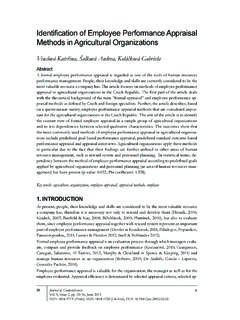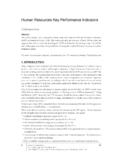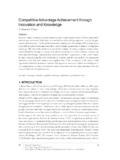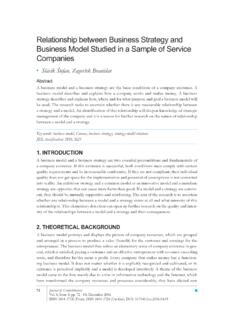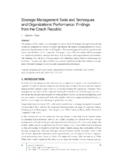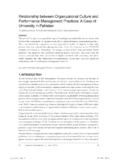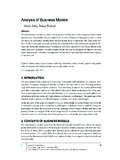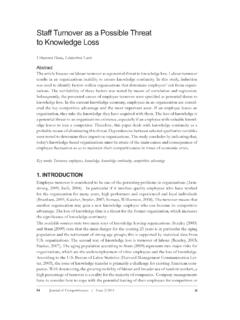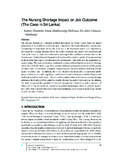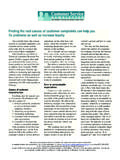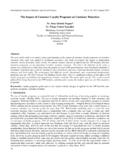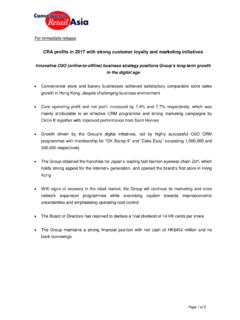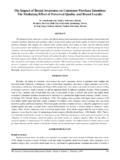Transcription of The Relationship between Service Quality, Customer ...
1 The Relationship between Service quality , Customer Satisfaction and Customer loyalty : An Investigation in Vietnamese Retail Banking Sector Ngo Vu Minh, Nguyen Huan Huu Abstract This study develops and empirically tests the interrelationships between Service quality , cus- tomer satisfaction, and Customer loyalty in a retail banking context. Increasingly intense com- petitiveness and fundamental changes in the business environment nowadays are forcing firms to implement a Customer -focused strategy which raises the importance of Customer -related con- structs such as Customer satisfaction, Service quality , and Customer loyalty in explaining a firm's performance. In particular, they are essential for competitiveness in industries where the ex- changes are complex and customers are closely involved in the decision-making process, such as the banking industry. In this study, first, a research model about the interrelationships between Service quality , Customer satisfaction, and Customer loyalty is suggested.
2 Then a survey is con- ducted with retail banking customers about these constructs, which results in 261 valid respond- ents. The hypotheses are then proposed and tested using confirmatory factor analysis (CFA) and the structural equation modelling technique (SME). The analysis reveals that Service quality and Customer satisfaction are important antecedents of Customer loyalty and Customer satisfaction mediates the effects of Service quality on Customer loyalty . These findings suggest that there are non-linear relationships between three constructs and emphasize the need to treat Customer loyalty management as a process which includes plenty of factors interacting with each other. Key words: Service quality , Customer satisfaction, Customer loyalty , banking, competitive and mediators. JEL Classification: M10, M20, M31. 1. INTRODUCTION. It might be well accepted nowadays that intensive competitiveness in terms of both quantity and quality makes it extremely difficult for a firm to differentiate itself from its competitors.
3 Moreover, dynamic business environments and increasing Customer power have pushed firms toward a Customer -focused strategy, especially using new technology to build relationships with the Customer (Ryding, 2010). As a result, excellent business processes and intangible assets such as brands, Customer satisfaction, and powerful human resources might become the most es- sential sources of sustainable competitive advantages (Chien & Tsai, 2012; Teece, 2007; Wang & Ahmed, 2007). These fundamental changes, together with the invisible and hard-to-observe characteristics of qualitative/non-financial measures, have raised the questions of whether non- financial measures such as Customer satisfaction and job satisfaction have real and significant effects on firm performance and how they do it. Among them, Customer loyalty has been consid- Journal of Competitiveness 103. Vol. 8, Issue 2, pp. 103 - 116, June 2016. ISSN 1804-171X (Print), ISSN 1804-1728 (On-line), DOI: 103 13:43:18.
4 Ered as one of the most important competitive edges in today's business environment, in which the purchasing power of the Customer is increasing while companies have to encounter limitless challenges from their competitors (Pan, Sheng, & Xie, 2012; Sharma, 2007). Therefore, for cost reduction and profit improvement reasons and to build sustainable competitiveness, maintaining long-term Customer loyalty is a mandatory task. In this context, both practitioners and research- ers have searched for the most important antecedents of Customer loyalty . Many studies in the Relationship marketing literature have demonstrated that Customer satisfaction is one of the most popular determinants of Customer loyalty (Flint, Blocker, & Boutin, 2011; Mittal & Kamakura, 2001; Tsai, Tsai, & Chang, 2010). Although there is a consensus among researchers that satisfac- tion can be a basis for achieving loyalty , researchers also agree that the satisfaction- loyalty rela- tionship should have more ingredients.
5 In this stream of research, previous studies have devel- oped and applied some theoretical and conceptual frameworks which can extend and elaborate the satisfaction- loyalty Relationship , such as the Balanced Scorecard (BSC) and the Service -profit chain frameworks (Heskett, Jones, Loveman, Sasser Jr., & Schlesinger, 2008; Kaplan & Norton, 1992; Tayler, 2010). These frameworks view Customer loyalty and financial sequences as the top and final sequences of a system and proposed completed set of cause-and-effects relation- ships between different organizational factors such as a learning organization, excellent internal Service , employee satisfaction, and excellent business processes to achieve them. Among these factors, excellent business processes which lead to product/ Service quality can be seen as the direct factors impacting on Customer satisfaction and Customer loyalty (Brady, Cronin, & Brand, 2002; Chu, Lee, & Chao, 2012). If these relationships are valid, managers can understand the sources of Customer satisfaction and Customer loyalty more clearly in order to give better Service to the Customer and improve the firm's financial performance.
6 Therefore, using the context of a new banking Service , this study develops and empirically tests the interrelationships between Service quality , Customer satisfaction, and Customer loyalty . The main objective of this study is to confirm and provide new empirical evidence about the interrelationships between Service quality , Customer satisfaction and Customer loyalty which are suggested in the above-mentioned conceptual frameworks. The rest of this study is divided into sections, as follows. First, the next section provides the theoretical background and develops the hypotheses for this study. Second, the research meth- odology is developed and put into use. Third, in order to test the hypotheses, data analysis and results are presented. Finally, the findings of this study are concluded and managerial implica- tions and limitations are discussed 2. THEORETICAL BACKGROUND AND HYPOTHESES. Customer loyalty Customer loyalty can be defined as the closest step to the repurchasing behaviour of custom- ers.
7 Customer loyalty has usually been referred to as a consequence of all the experiences that a Customer has with a Service /product provider (Mascarenhas, Kesavan, & Bernacchi, 2006). The experiences might include physical interactions, emotional involvements, and value chain moments, according to Mascarenhas et al. (2006). In term of loyalty 's consequences, a shift to a 104 Journal of Competitiveness 104 13:43:18. loyalty strategy from an only-satisfaction strategy can substantially increase Customer retention and reduce marketing costs (Stan, Caemmerer, & Cattan-Jallet, 2013). Camarero et al. (2005). found from a Spanish case study that Customer loyalty has positive impacts on both a firm's mar- ket performance and its economic performance. Generally, Customer loyalty has been referred to as the link between Customer attitude, repeat purchasing, and financial performance (Heskett et al., 2008). In terms of the antecedents of Customer loyalty , a number of constructs have been proposed by previous studies.
8 Yee, Yeung, and Cheng (2010) found that employee loyalty , Service quality , and Customer satisfaction have a positive influence on Customer loyalty in a high-contact Service industry. In addition, according to Oliver (1999), loyalty can be developed through differ- ent phases, which are cognitive sense, affective sense, conative manner, and finally behavioural manner. The first three phases are usually referred as attitudinal loyalty which are dependent on the experiences that customers have with Service providers (overall satisfaction). Completing these three stages can lead to the behavioral loyalty as the final stage. This evolvement process of Customer loyalty is confirmed by a meta-analysis about the antecedents of Customer loyalty by Pan, Sheng and Xie (2012). In this study, by conducting a meta-analysis, the authors also found the empirical evidences supporting that Customer satisfaction, trust, commitment and loyalty program memberships have positive influences on Customer loyalty .
9 In addition, the product- related attributes such as quality , value, brand reputation and switching cost also determine level of loyalty from customers. In this study, the author attempt to evaluate the relationships between Customer loyalty and two other constructs which are popular in Relationship marketing, espe- cially in Service context industry, Customer satisfaction and Service quality . Service quality and Customer satisfaction Customer satisfaction is becoming one of the most essential objective which any firm seeking for long-term Relationship with Customer considers as the top priority. In retail banking context where the contacts with customers are one of the most core business processes, Customer satis- faction is becoming the key for successful (Belas & Gabcova, 2014; Belas, Cipovova & Demjan, 2014; Chavan & Ahmad, 2013). One of the main element determining Customer satisfaction is the Customer 's perception of Service quality . Customer satisfaction is described as the result of a comparison of the customers' expectations and his or her subsequent perceived perform- ance of Service quality (Herington & Weaven, 2009).
10 According to this conceptualization, per- ceived Service quality is one of the antecedents to overall Customer satisfaction. Previous studies showed the evidence support this Relationship between Customer satisfaction and Service quality (Yee, Yeung, & Cheng, 2011). Even though, there are also debates about the causal Relationship between Customer satisfaction and Service quality . Specifically, there are three major positions about this Relationship in the literature (Brady et al., 2002). First, as indicated above, Service quality is described as an antecedents to Customer satisfaction (Naik, Gantasala, & Prabhakar, 2010; Olorunniwo, Hsu, & Udo, 2006). Second, some researchers suggest that Customer satisfac- tion is the cause of Service quality (Bitner, 1990). The third position of the Service quality - satis- faction Relationship argues that neither satisfaction nor Service quality may be antecedent to the other (Dabbolkar, 1995; McAlexander, Kaldenberg, & Koenig, 1994).

